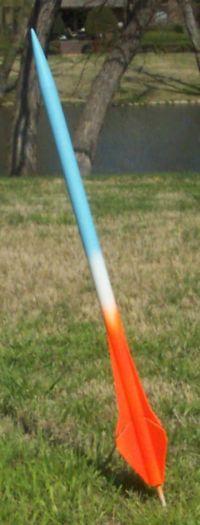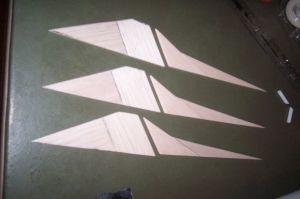| Construction Rating: | starstarstarstarstar_border |
| Flight Rating: | starstarstarstarstar |
| Overall Rating: | starstarstarstarstar_border |
| Manufacturer: | Thrustline Aerospace |

Brief:
This is a single stage sport rocket with a long airframe and split fin design
which give it nice lines and makes for a lot of curious rocketeers at any
launch.
Construction:
The kit is composed of two 1.325" diameter body tubes, balsa nosecone,
eyelet, motor tube, two centering rings, metal engine hook, launch lug,
Kevlar®
and elastic shock cords, 18" mylar parachute, and balsa fin stock.
When you first open the Duster kit you are impressed by the instructions. There is a photo provided at nearly every step of the build. As usual I upgraded a few things during the build including the motor mount. I went with an E length 24mm mount also purchased from Thrustline.
I did some simulations with SpaceCAD to ensure stability though. Initially it recommended adding 1/2 oz of weight in the nose, but as I typically build pretty sturdy and use a number of primer/paint layers in finishing, I decided to wait until build completion and check again. As expected, I had a decent CP/CG ratio and didn't have to add any nose weight.
Probably the trickiest part of the build was the layout and finish of the fins. There are six in all and each fin was recommended to be laid out in two pieces (12 pieces total). In theory, this is to align the long leading edge of each piece with the grain of the balsa for maximum strength. This made sense but the picture of the layout provided didn't accomplish the task, thus I used an altered layout. I had more than enough room on the balsa stock to accomplish what was needed. In any case, make sure to lay out the fins exactly so the angles are right and sand so each piece fits its mate exactly. If you end up with any slight gaps they can be filled with Elmer's Fill 'n' Finish or other similar product.
 A
number of references in the instructions mention using yellow glue and CA. I
seldom use either and prefer 5-minute epoxy for low power rocket builds which
is what I used on the Duster.
A
number of references in the instructions mention using yellow glue and CA. I
seldom use either and prefer 5-minute epoxy for low power rocket builds which
is what I used on the Duster.
Overall the build was great and very enjoyable. I always have an LPR kit sitting around to build in between HPR projects. The Thrustline Duster has to be one of my favorites.
Finishing:
I like a glass smooth finish so I use quite a bit of primer and a number of
coats of paint. I used Rustoleum primers and Krylon colors and then finished it
with Krylon matte clear coat. This final clear coat was mostly used as a test.
I could see myself needing a flat finish on some HPR projects I had coming up,
so this was my test case. Very smooth finish on the paint as usual with Krylon.
Krylon matte was easy to use. I put five or six coats on with light 600 grit
sanding in between and it turned out great. Durability was a question but after
four flights over a five month time period, it still looks super!
Construction Rating: 4 out of 5
Flight:
I had upgraded the motor mount to accept an Estes E sized engine. To be safe
though, I started with a C11-5 at a nearby field in my subdivision. It was a
slow liftoff as I believe the motor took a while to ignite. Once lit though, it
flew straight and true. Not too high, probably around 750 feet. Perfect
deployment and nearby recovery.
Second and third flights were at one of our club launches. I went for the E9-6 for the first flight of the day. Wow! It exploded off the pad. It simmed at greater than 1500' and I'm sure it got there. My son was along and did the trek of about 900 yards to retrieve the rocket.
The final flight of the same day was again a C11-5. Actually I kind of like that launch profile the best. Starts a little slow off the pad then goes like a bat out of hell.
Recovery:
Excellent shock cord attachment with Kevlar®
running from the motor mount through the airframe and a few feet out the
forward end of the body, then a 1/4" elastic shock cord attached from the
Kevlar®
to the nosecone. The kit contains a superb 18" mylar parachute and
Kevlar®
shroud lines which Thrustline is known for.
For flight prep, I simply used a bit of blown insulation, packed the parachute carefully and inserted in the airframe. The fit of the chute is a little tight in the 1.325" airframe but have had picture perfect recoveries every flight so far. Only a couple of slight black marks on the lower end of the Kevlar® cord after four flights.
Flight Rating: 5 out of 5
Summary:
The Thrustline Duster is a great low power kit. Very attractive split fin
design. Superb, high quality recovery components. Great flight profiles with C
and D engines although, I would recommend upgrading to the longer 24mm mount as
I did giving you even more options as a sport flyer with E engines.
Overall Rating: 4 out of 5
Other Reviews
- Thrustline Aerospace Duster By Matthew Bond
Brief: The Duster is an original design from John Rowan-Stern at Thrustline Aerospace. The Duster is a fairly large, high performance model rocket designed to fly primarily on Estes 24mm black powder motors (C11/D12) and is rated a skill level 2/3 build. The Duster is built around a BT-55 airframe, sports a sleek split fin design, and a conical nose cone. The best way to describe ...
 |
 |
Flights
 |
 |